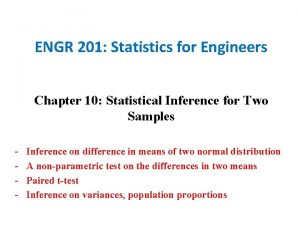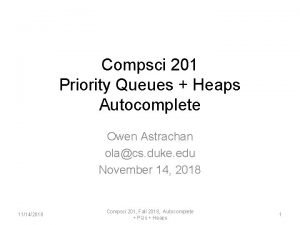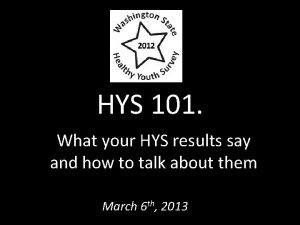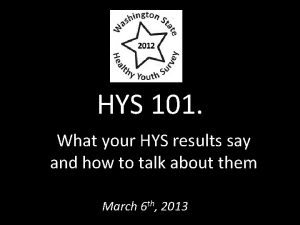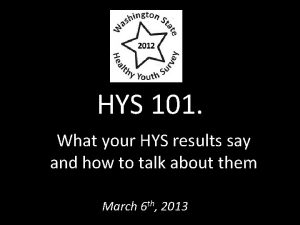HYS 201 Digging Deeper Into Your HYS Results































































- Slides: 63

HYS 201. Digging Deeper Into Your HYS Results March 20 th, 2013

Training Overview 1. Statistical issues 2. Data analysis with the Q x Q 3. Message communication

HYS Statistical Issues

Generalizability • Can we “generalize” from the survey to the population? • Challenges to generalizability: o Response rates (why 70%? ) o Are different for schools, districts, counties o Need to consider how these challenges affect interpretation of the results

Do I need to generalize? • Yes, if you want to apply the results to a larger population. o 8 th graders in our district said…. • Yes, if you want to compare to others or results over time • No, if you want to just describe the students surveyed, in that moment, without confidence intervals: o Students at our school who took the survey said….

Understanding N’s “N” is shorthand for “number” --- the number of students who took this survey or who answered a survey question. There are multiple reasons why different questions have different “N’s”: • Maybe a question is near the end of the survey… • Maybe a question is difficult to answer, or too personal…

So many N’s….

Converting N’s into students Each question has an “N” for the number of students who answered it. Using your “N”, you can translate your point estimate (%) into the number of students • For example, o If 10% of students in your district used inhalants, o 200 10 th graders , o Then 20 students in your district used inhalants (20 X 0. 10)

Confidence intervals

What are “confidence intervals”? ± ± HYS results include a “±” after the number for each answer in the survey results. ± It is unlikely that the point estimate (%) is exact. Confidence intervals (CI) describe uncertainty. • • ± Results are different than the “true” value. “We are 95% sure that…. ” ±

Why do we need confidence intervals if data are valid? • CIs account for variability, NOT the validity of the data. • Variability causes uncertainty in the results. • CIs allow for the comparison of results to others and to ourselves over time.

“Doubt is not a pleasant condition, but certainty is absurd. ” – Voltaire

Why are confidence intervals different sizes? The size of a confidence interval is affected by: • Number of students. o In general, the more students surveyed, the smaller the confidence interval. • Inherent variability. o If most students answer a survey question in the same way, then there is less variability. The more variable the answers, the wider the CIs.

Using results with large confidence intervals If you are a small school, district or county your CIs will be large. . . • The estimate may be good, but only of the students who took the survey this year. CIs don’t take participation rates into account: • Low participation – there may be additional bias • High participation – you can feel more confident in your point estimates.

Statistical significance

What is “statistical significance”, and when does it matter? • The probability that differences in results are not due to chance alone. • When using 95% confidence intervals, a difference between two groups is considered statistically significant if chance could explain it only 5% of the time or less.

Using confidence intervals • CIs help you decide if the difference between your students and the state are statistically significant. • Example, your students report 25% ± 5%. o So your CI is between 20% and 30% o Math: 25% - 5% = 20%, 25% + 5% = 30%

1: Significant or non-significant? • Your students report 25% ± 5% • Students statewide report 36% ± 3% o So your point estimate is 25% your CI is between 20% and 30% o So the point estimate is 36% your CI is between 33% and 39% The CIs don’t overlap, so the difference is significant

2: Significant or non-significant? • Your students report 25% ± 5% • Students statewide report 28% ± 3% o So your point estimate is 25% your CI is between 20% and 30% o So the point estimate is 28% your CI is between 25% and 31% The CI for your students overlaps the point estimate for students statewide, so the difference is not significant

3: Significant or non-significant? • Your students report 25% ± 5% • Students statewide report 36% ± 3% o So your point estimate is 25% your CI is between 20% and 30% o So the point estimate is 36% your CI is between 33% and 39% The CIs overlap, but don’t include the other point estimates, so we don’t know if they are different…

Tool for testing significance If you need to know for sure, there is a “Tool” to test for significance at: www. Ask. HYS. net/Training The spreadsheet tests the difference between two point estimates and their 95% CI to compute a pvalue. • • • If your p-value is less than 0. 05, then your difference is significant. Only use this test if you have at least 30 students. Don’t use this test if you have 0% or 100%

Example – Comparing to the state Since we couldn’t tell if there was a difference by using our CIs – let’s try the “Tool”: • • Your students: 25. 0% (± 5. 0) Students statewide: 36. 0% (± 3. 0) 25. 0 36. 0 3. 0 Your students Statewide 0. 0002177 P-value is less than 0. 05, so there is a significant difference.

Example – Comparing grades Are their differences in drinking 2 or more sodas between 10 th and 12 th graders? • • 10 th grade: 15. 3% (± 1. 7) 12 th grade: 14. 7% (± 1. 9) P-value is greater than 0. 05, so there is no difference between 10 th and 12 th graders.

Example – Comparing gender Are their differences in drinking 2 or more sodas between male and female 10 th graders? • • Male: 20. 5% (± 2. 3) Female: 10. 5% (± 1. 9) P-value is less than 0. 05, so 10 th grade males are more likely to drink 2 or more sodas, compared to females.

Comparisons over time A few things to think about first: • • Did the survey change? • Do you expect a change? Were challenges to generalizability similar? o Response rates o Groups of students missing

Trends • • Fact sheets do provide data back to 2002 for some questions – but do not provide trend results (only year to year comparisons) To measure trends you need statistical software o Free software from the National Cancer Institute – uses your point estimates and confidence intervals: http: //surveillance. cancer. gov/joinpoint

Questions?

Qx. Q Online Data Query System

Q x Q = Question by Question What can you do with it? • Run frequencies: responses to individual questions. Just like the results in your Frequency Reports. • Run crosstabs: looking at the relationship between two questions - crossing one question by the second question.

Availability and access What is available? • Grades 6, 8 , 10 and 12 • Years from 2002 to 2012 (2012 almost ready…. ) • Locations with results (must meet minimum qualifications) Anyone can access: • State, Educational Service District, and County results A username/password are required to access: • School District and Building results (permission provided by District Superintendent)

Before you start, ask yourself… What do you want to know? Do you have results to analyze? • Check Past Participation Can the questions you’re interested in be crossed? • Check the Crosswalk

Past participation

Opening the Q x Q www. Ask. HYS. net/Analyzer Fact Sheets Frequency Reports Qx. Q Analysis Past Participation

Opening the Q x Q www. Ask. HYS. net/Analyzer

Opening the Q x Q www. Ask. HYS. net/Analyzer

For district and building queries susan@rainiertheory. com ****

For district and building queries

For district and building queries

Run a frequency

Frequency - Selecting analysis variables

Frequency - Question selection

Frequency - Drag and drop

Frequency - Response selection

Frequency output

What are crosstabs

Relationship between drinking and marijuana Among kids who didn’t drank: • 3. 5% used marijuana (cell 2) Among kids who drank: • 44. 8% used marijuana (cell 4) Current Alcohol Drinking and Current Marijuana Use

Relationship between marijuana and drinking Among kids who didn’t use marijuana: • 8. 8% drank (cell 2) Among kids used marijuana: • 68. 5% drank (cell 4)

HYS crosstab requirements Cell size • State level minimum 5 per cell. • Sub-state level minimum 10 per cell. **NOTE** • The squares that have results in them are the “cells”. • The number of respondents in each cell is called the “n”, or also the “cell size”.

Cell size error message “At least one cell in the results table contained a count of less than 10. ” Output is suppressed. ” Cell size limitations can be frustrating! If your results are suppressed because of cell size: • • Select the “collapsed” answer option instead of the “surveyed” option. Re-run your crosstab at a higher geography – like county rather than district.

Survey form error message “No surveys contained responses to all the selected variables”. Form A ½ students Core All students Form B ½ students

Run a Crosstab

1: Choose analysis variables

2: Populate query builder

3: Add row and column variables

4: Choose response options & run

Alcohol and marijuana example Row Variable = Current Alcohol, Column Variable = Current Marijuana Year=2010, Grade=8 Among kids who didn’t drank: • 3. 5% used marijuana (cell 2) Among kids who drank: • 44. 8% used marijuana (cell 4) Current Alcohol Drinking and Current Marijuana Use

Right way - Race and bullying Bullied Row Variable = Race, Column Variable = Bullying Year=2010, Grade=8 no days API AI/NA Among Asian or Pacific Islanders: • 29. 1% were bullied Black Race Among Whites: • 30. 9% were bullied Latino White Multi-Other any days Total 70. 9% ± 2. 4% 701 29. 1% ± 2. 4% 288 100. 0% 71. 7% ± 5. 7% 185 28. 3% ± 5. 7% 73 100. 0% 74. 8% ± 4. 2% 351 25. 2% ± 4. 2% 118 100. 0% 73. 3% ± 3. 1% 911 26. 7% ± 3. 1% 331 100. 0% 69. 1% ± 1. 8% 3, 163 30. 9% ± 1. 8% 1, 417 100. 0% 67. 0% ± 2. 5% 1, 001 33. 0% ± 2. 5% 494 100. 0% 989 258 469 1, 242 4, 580 1, 495

Wrong way - Race and bullying Row Variable = Bullying, Column Variable = Race, Year=2010, Grade=8 Among Asian or Pacific Islanders: • 10. 6% were bullied Among Whites: • 52. 1% were bullied Race Bullied API AI/NA Black Latino White Multi. Other Total no days 11. 1% ± 2. 8% 701 2. 9% ± 0. 5% 185 5. 6% ± 1. 5% 351 14. 4% ± 1. 3% 911 50. 1% ± 5. 4% 3, 163 14. 9% ± 1. 3% 1, 001 100. 0% any days 10. 6% ± 2. 8% 288 2. 7% ± 0. 7% 73 4. 3% ± 1. 3% 118 12. 2% ± 3. 4% 331 52. 1% ± 5. 2% 1, 417 18. 2% ± 1. 8% 494 100. 0% 6, 312 2, 721

Two ways to look at it Row Variable = Weapons at School, Column Variable = Grades Last Year, Year=2010, Grade=8 Row Variable = Grades Last Year, Column Variable = Weapons at School, Year=2010, Grade=8 • 47. 5% of youth who carried weapons at school had low grades (C-D-F’s) • 3. 8% of youth who had high grades (AB’s) carried a weapon at school • 24. 5% of youth who did not carry weapons at school had low grades (C-D -F’s) • 10. 0% of youth who had low grades (CD-F’s) carried a weapon at school Weapon at School Mostly A-B’s Mostly C-D-F’s Total no days 75. 5% ± 2. 5% 6, 521 24. 5% ± 2. 5% 2, 111 100. 0% any days 52. 5% ± 4. 6% 259 47. 5% ± 4. 6% 234 100. 0% 8, 632 493 Grades Last Year Weapon at School Grades Last Year no days any days Total Mostly A-B’s 96. 2% ± 0. 7% 6, 521 3. 8% ± 0. 7% 259 100. 0% Mostly C-D-F’s 90. 0% ± 1. 1% 2, 111 10. 0% ± 1. 1% 243 100. 0% 6, 780 2, 345

Check you Q x Q results You can compare your Q x Q frequency results with your Frequency Reports (www. Ask. HYS. net/Reports) • Page 4 in your reports includes crosstabs by gender Ask someone to review your results **NOTE** There may be slight differences because of the way different statistical programs round numbers.

Questions?

Thank you! From the Joint Survey Planning Committee • • DASA-DBHR: Linda Becker, Steve Smothers, Grace Hong OSPI: Dixie Grunenfelder Commerce: Ramona Leber DOH: Kevin Beck, Vivian Hawkins, Lillian Bensley, Juliet Van. Eenwyk Liquor Control Board: Mary Segawa Looking Glass: Joe Kabel Rainier Theory: Susan Richardson

Questions? About this training: • Linda Becker: Becke. LG@dshs. wa. gov • Dixie Grunenfelder: Dixie. Grunenfelder@k 12. wa. us • Susan Richardson: susan@rainiertheory. com Other HYS questions: • healthy. youth@doh. wa. gov • www. Ask. HYS. net
 Into the heart of jesus deeper and deeper i go
Into the heart of jesus deeper and deeper i go Civil war digging deeper webquest answers
Civil war digging deeper webquest answers Your love is deeper than the ocean higher than the heavens
Your love is deeper than the ocean higher than the heavens Digging seamus heaney theme
Digging seamus heaney theme Squat pen
Squat pen Joints used in volleyball
Joints used in volleyball Give us your hungry your tired your poor
Give us your hungry your tired your poor Go deeper in christ
Go deeper in christ Deeper life bible church messages
Deeper life bible church messages Deeper life bible church netherlands
Deeper life bible church netherlands Deeper life bible church netherlands
Deeper life bible church netherlands Deeper life search the scriptures volume 1
Deeper life search the scriptures volume 1 Deeper
Deeper Deeper life sunday message
Deeper life sunday message Deeper life netherlands
Deeper life netherlands Vaap curriculum framework
Vaap curriculum framework Deeper life bible church
Deeper life bible church Deeper life youth search the scripture
Deeper life youth search the scripture Growing deeper in god
Growing deeper in god Deeper life netherlands
Deeper life netherlands Deeper life netherlands
Deeper life netherlands Deeper life search the scriptures volume 78
Deeper life search the scriptures volume 78 Deeper life bible church netherlands
Deeper life bible church netherlands Deeper life netherlands
Deeper life netherlands Deeper life canada
Deeper life canada Piled higher and deeper
Piled higher and deeper Deep dive synonyms
Deep dive synonyms Kelly gallagher deeper reading
Kelly gallagher deeper reading Deeper life netherlands
Deeper life netherlands Deeper life netherlands
Deeper life netherlands Deeper life netherlands
Deeper life netherlands Deeper life netherlands
Deeper life netherlands Deeper life bible church netherlands search the scriptures
Deeper life bible church netherlands search the scriptures Netherlands
Netherlands Deeper life netherlands
Deeper life netherlands Nf p 40-201
Nf p 40-201 Mcb 201
Mcb 201 Math portfolio project
Math portfolio project Seramikler hangi bağ çeşidine sahiptir
Seramikler hangi bağ çeşidine sahiptir Cartoons
Cartoons Fst 201
Fst 201 14-13
14-13 Engr 201
Engr 201 201 principles of software development pdf
201 principles of software development pdf Duke cs 201
Duke cs 201 Cmsc 201 umbc
Cmsc 201 umbc Cmsc 201 umbc
Cmsc 201 umbc Class 201
Class 201 Clase 201 descubriendo mi madurez espiritual pdf
Clase 201 descubriendo mi madurez espiritual pdf Fmvss 201
Fmvss 201 Bch 201
Bch 201 5 c.f.r. § 2640.201
5 c.f.r. § 2640.201 Kentucky nurse practitioner license
Kentucky nurse practitioner license 201 isabella st pittsburgh pa 15212
201 isabella st pittsburgh pa 15212 English 201
English 201 Dd 2708
Dd 2708 What is software
What is software Se-201
Se-201 Records management 201
Records management 201 Patrio eztec
Patrio eztec Choco de jesus
Choco de jesus Jeffrey miller usc
Jeffrey miller usc Met 201
Met 201 Cpit 201
Cpit 201










































